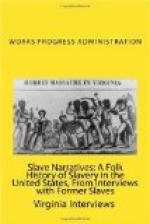“At that time, there were about four houses to the block. On the place where we lived there was the big house, with many rooms, and then there was the barn and a lot of other buildings. My father rented that place and turned the outbuildings into little houses and allowed the freed slaves to live in them till they could find another place.
“My husband was an orphan child, and the people he was living with were George Phelps and Ann Phelps. They were freed slaves. That was after the war. They came here and had this little boy with them, that is how I come to meet that gentlemen over there and get acquainted with him. When they moved away from there Phelps was caretaker of the Oakland Cemetery. We married on the twenty-seventh day of March, 1879. I still have the marriage license. I married twice; my first husband was George W. Glenn and my maiden name was Jackson. I married the first time June 10, 1875. I had two children in my first marriage. Both of than are dead. Glenn died shortly after the birth of the last child, February 15, 1878.
“Mr. White is a mighty good man. He is put up with me all these years. And he took mighty good care of my children, them by my first husband as well as his own. When I was a little girl, he used to tell me that he wouldn’t have me for a wife. After we were married, I used to say to him, ’You said you wouldn’t have me, but I see you’re mighty glad to get me.’
“I have the marriage license for my second marriage.
“There’s quite a few of the old ones left. Have you seen Mrs. Gillam, and Mrs. Stephen, and Mrs. Weathers? Cora Weathers? Her name is Cora not Clora. She’s about ninety years old. She’s at least ninety years old. You say she says that she is seventy-four. That must be her insurance age. I guess she is seventy-four at that; she had to be seventy-four before she was ninety. When I was a girl, she was a grown woman. She was married when my husband went to school. That has been more than sixty years ago, because we’ve been married nearly sixty years. My sister Mary was ten years older than me, and Cora Weathers was right along with her. She knew my mother. When these people knew my mother they’ve been here, because she’s been dead since ’94 and she would have been 110 if she had lived.
“My mother used to feed the white prisoners—the Federal soldiers who were being held. They paid her and told her to keep the money because it was Union Money. You know at that time they were using Confederate money. My father kept it. He had a little box or chest of gold and silver money. Whenever he got any paper money, he would change it into gold or silver.
“Mother used to make these ginger cakes—they call ’em stage planks. My brother Jimmie would sell them. The men used to take pleasure in trying to cheat him. He was so clever they couldn’t. They never did catch him napping.
“Somebody burnt our house; it was on a Sunday evening. They tried to say it caught from the chimney. We all like to uv burnt up.




